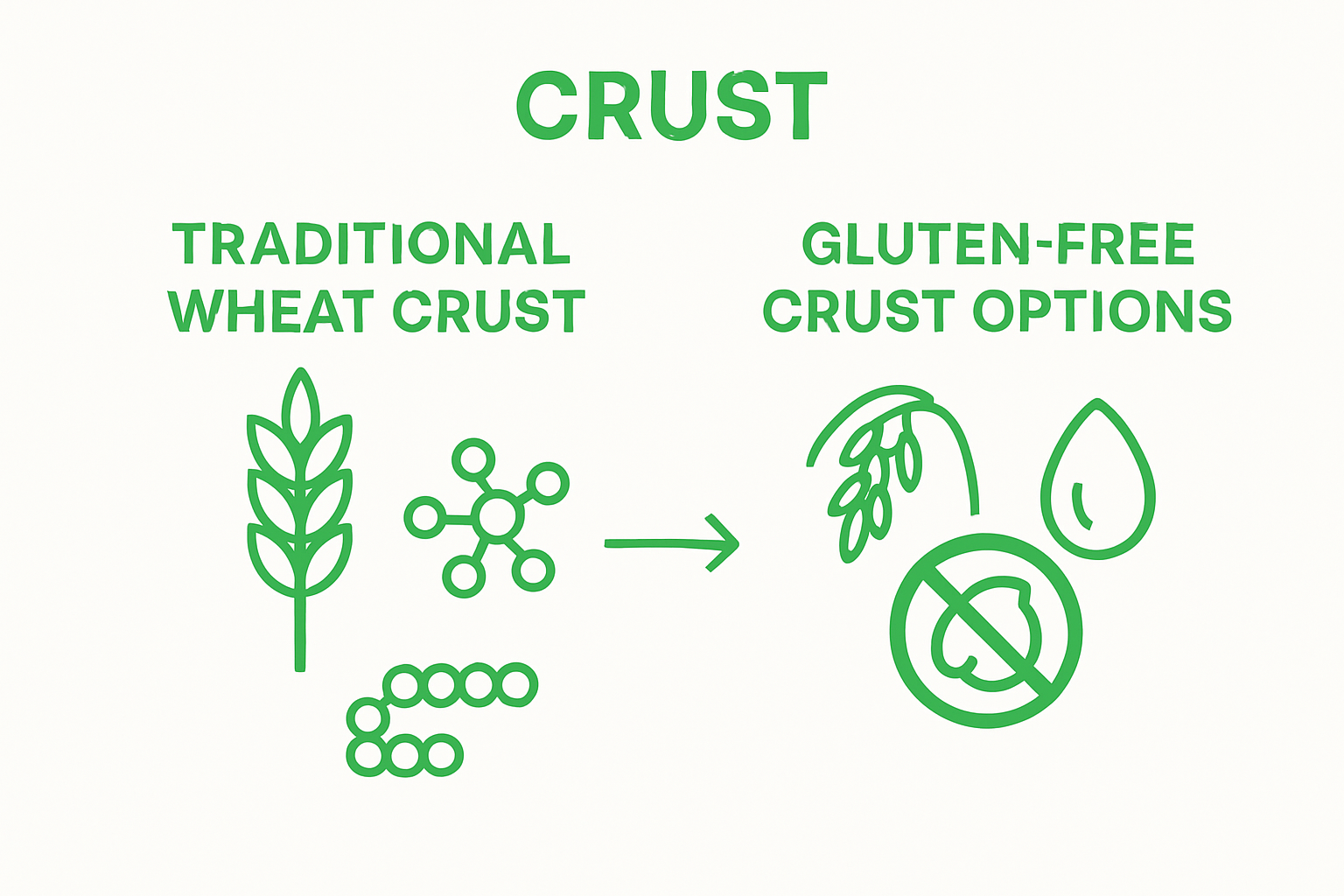Gluten free pizza crusts are changing how millions approach eating and health. More than 1 in 100 Brits are diagnosed with coeliac disease and strict gluten avoidance is the only solution. Yet many people think gluten free means bland and boring. That could not be further from the truth. Some gluten free crusts now feature protein rich flours and science backed methods to create textures so good you would never guess they are wheat free.
Table of Contents
- Defining Gluten Free Pizza Crust Options
- The Importance Of Gluten Free Diets
- Exploring Different Types Of Gluten Free Pizza Crust
- Key Ingredients In Gluten Free Pizza Crusts
- Choosing The Right Gluten Free Pizza Crust For Your Needs
Quick Summary
| Takeaway | Explanation |
|---|---|
| Gluten free crusts cater to dietary restrictions. | Gluten free pizza crusts provide safe options for coeliac disease, gluten sensitivity, and health-conscious individuals. |
| Explore diverse flour alternatives for nutrition. | Options like almond, chickpea, and rice flour offer varying nutritional benefits and unique textures to enhance the pizza experience. |
| Understand health implications of gluten free diets. | For individuals with gluten-related disorders, strict adherence to gluten free diets is crucial for managing health and preventing complications. |
| Choose crusts based on personal health requirements. | Selecting the right gluten free crust involves assessing dietary restrictions, allergens, and personal taste preferences. |
| Evaluate nutritional content in crust choices. | It’s vital to consider protein, fibre, and micronutrient levels across different crust options to support overall health and wellness. |
Defining Gluten Free Pizza Crust Options
Gluten free pizza crusts represent a transformative solution for individuals managing dietary restrictions or seeking healthier alternatives. These specialised crusts eliminate wheat based ingredients traditionally containing gluten, offering a safe and delicious option for people with coeliac disease, gluten sensitivity, or those pursuing wellness through dietary choices.
Understanding Gluten and Pizza Crusts
Traditional pizza crusts typically rely on wheat flour, which contains gluten proteins that provide elasticity and structure. Gluten free pizza crusts replace these ingredients with alternative flour sources that naturally lack gluten proteins. Common alternatives include rice flour, almond flour, chickpea flour, and corn flour, each contributing unique nutritional profiles and textures to the final product.
Key characteristics of gluten free pizza crusts include:
- Complete absence of wheat based ingredients
- Nutritionally diverse flour alternatives
- Carefully processed to prevent cross contamination
- Compliance with strict gluten free certification standards
Nutritional and Health Considerations
Gluten free pizza crusts are not just about dietary restriction management but also represent a pathway to diverse nutritional intake. Different flour alternatives offer varied health benefits. For instance, almond flour provides protein and healthy fats, while chickpea flour delivers additional fibre and plant based protein.
According to the US Food and Drug Administration, gluten free products must contain less than 20 parts per million of gluten to be officially classified and labelled as gluten free. This regulation ensures consumers can confidently select products matching their dietary requirements.
Consumers exploring gluten free pizza crust options should consider individual nutritional needs, taste preferences, and potential allergen interactions when selecting their ideal alternative.
Below is a comparison table outlining the key characteristics of common gluten free flours used for pizza crusts, assisting in understanding their differences for dietary and sensory needs.
| Gluten Free Flour | Key Nutritional Benefits | Typical Texture | Flavour Profile |
|---|---|---|---|
| Rice Flour | Low fat, easy to digest | Smooth, light, tender | Mild, neutral |
| Almond Flour | High protein, healthy fats | Dense, moist, chewy | Nutty, rich |
| Chickpea Flour | High fibre, plant protein | Earthy, slightly grainy | Savoury, subtle nuttiness |
| Corn Flour | Provides carbohydrates | Crunchy, crisp | Slightly sweet |
| Quinoa Flour | High protein, minerals | Soft, slightly crumbly | Nutty, robust |
| Amaranth Flour | Protein, fibre, micronutrients | Slightly sticky, dense | Earthy, grassy |
The Importance of Gluten Free Diets
Gluten free diets have evolved from a niche dietary requirement to a mainstream nutritional approach addressing critical health needs for millions worldwide. Understanding the broader implications of eliminating gluten goes far beyond temporary food trends, representing a significant health management strategy for various medical conditions.
Medical Necessity and Health Implications
For individuals with coeliac disease, a gluten free diet is not a choice but a critical medical necessity. When people with this autoimmune disorder consume gluten, their immune system responds by damaging the small intestine, leading to potential nutrient malabsorption, chronic inflammation, and long term health complications. Strict gluten elimination becomes the primary treatment protocol, preventing intestinal damage and supporting overall wellness.
Key health conditions requiring gluten free diets include:
- Coeliac disease
- Non coeliac gluten sensitivity
- Wheat allergy
- Certain autoimmune disorders
- Neurological conditions with gluten sensitivity
Nutritional Perspectives and Wellness Benefits
Beyond medical requirements, gluten free diets can offer broader nutritional advantages. Many individuals report improved digestive comfort, reduced inflammation, and enhanced energy levels after transitioning. While not universally applicable, these dietary modifications can support individual wellness journeys.
For those interested in exploring related dietary insights, our guide on understanding ghee and gluten provides additional nutritional context.
According to medical research published in Nutrients, adherence to a gluten free diet remains the most effective intervention for managing coeliac disease and preventing potential long term health complications. The research emphasises that professional nutritional guidance is crucial when implementing such dietary changes to ensure balanced nutrition.
This table summarises the main health conditions for which a gluten free diet is a necessity and outlines the implications of gluten consumption for affected individuals.
| Health Condition | Need for Gluten Free Diet | Consequence of Gluten Consumption |
|---|---|---|
| Coeliac Disease | Essential | Intestinal damage, nutrient malabsorption |
| Non Coeliac Gluten Sensitivity | Often necessary | Gastrointestinal discomfort, fatigue |
| Wheat Allergy | Required | Allergic reaction, potential anaphylaxis |
| Autoimmune Disorders | Sometimes advised | Possible symptom exacerbation |
| Neurological Gluten Sensitivity | Recommended in certain cases | Neurological symptoms, discomfort |
Exploring Different Types of Gluten Free Pizza Crust
Gluten free pizza crusts represent a diverse landscape of innovative ingredients, each offering unique textures, nutritional profiles, and culinary experiences. Modern food science has dramatically expanded options for individuals seeking delicious alternatives to traditional wheat based crusts.
Grain Based Gluten Free Alternatives
Natural grain alternatives provide robust foundations for gluten free pizza crusts. Rice flour emerges as a popular base, offering mild flavour and excellent texture. Corn flour delivers a slightly sweet undertone, while quinoa flour introduces complex protein structures and nutty characteristics. These grain alternatives replicate traditional pizza crust properties while maintaining strict gluten free standards.
Key characteristics of grain based gluten free crusts include:
- Diverse nutritional compositions
- Range of texture possibilities
- Lower glycemic impact compared to wheat flour
- Enhanced digestibility for sensitive individuals
Innovative Flour and Protein Combinations
Advanced gluten free pizza crust formulations increasingly blend multiple flour types to optimise taste and structural integrity. Combining almond flour with chickpea flour, for instance, creates crusts with enhanced protein content and improved mouthfeel. Pseudocereals like amaranth and buckwheat offer additional nutritional complexity and distinctive flavour profiles.
According to research published in Foods journal, innovative crust development involves sophisticated combinations of hydrocolloids, proteins, and fibers to improve texture and consumer acceptability. These scientific approaches transform gluten free pizza crusts from mere alternatives to genuinely enjoyable culinary experiences.
For individuals exploring diverse dietary options, understanding these nuanced crust variations opens exciting gastronomic possibilities beyond traditional wheat based pizzas.

Key Ingredients in Gluten Free Pizza Crusts
Gluten free pizza crusts represent a sophisticated fusion of alternative ingredients designed to replicate the complex structural and sensory characteristics of traditional wheat based crusts. Understanding the intricate composition of these ingredients reveals the scientific innovation behind creating delectable gluten free pizza experiences.
Foundational Flour Alternatives
The cornerstone of gluten free pizza crusts lies in selecting appropriate flour alternatives that provide structural integrity and nutritional value. Rice flour emerges as a primary ingredient, offering neutral flavour and smooth texture. Corn flour introduces subtle sweetness, while more complex options like quinoa and amaranth flour contribute enhanced protein content and distinctive nutritional profiles.
Key characteristics of foundational gluten free flours include:
- Naturally gluten free composition
- Varied nutritional density
- Unique textural properties
- Diverse flavour characteristics
Binding and Structural Enhancers
Critical to gluten free crust development are binding agents that replace the structural role traditionally performed by gluten proteins. Hydrocolloids such as xanthan gum and guar gum create essential elasticity and prevent crumbling. Protein rich ingredients like egg whites or plant based alternatives help maintain structural cohesion, mimicking the binding properties lost when eliminating wheat flour.
According to research published by the National Institutes of Health, sophisticated combinations of alternative flours, starches, and binding agents are fundamental in developing gluten free pizza crusts that satisfy both nutritional requirements and culinary expectations. These scientific approaches transform gluten free crusts from mere dietary alternatives to genuinely enjoyable gastronomic experiences.
Choosing the Right Gluten Free Pizza Crust for Your Needs
Selecting an appropriate gluten free pizza crust involves a nuanced understanding of individual dietary requirements, nutritional goals, and personal taste preferences. The diversity of available options demands a thoughtful approach to ensure both health considerations and culinary satisfaction.
Assessing Individual Dietary Requirements
Personal health conditions significantly influence gluten free pizza crust selection. Individuals with coeliac disease require absolute gluten elimination, while those with mild gluten sensitivity might tolerate different flour compositions. Understanding one’s specific nutritional needs becomes paramount in making an informed choice.
Key considerations when selecting a gluten free pizza crust include:
- Specific medical dietary restrictions
- Potential additional food allergies
- Nutritional profile requirements
- Personal taste and texture preferences
- Cooking and preparation methods
Nutritional and Sensory Evaluation
Beyond medical considerations, evaluating the nutritional content and sensory experience of gluten free pizza crusts is crucial. Protein content, fibre density, and micronutrient composition vary significantly across different flour alternatives. Almond flour crusts offer higher protein and healthy fat content, while chickpea flour provides enhanced fibre and plant based proteins.
According to research from the National Institutes of Health, sophisticated formulation techniques now enable gluten free pizza crusts that not only meet dietary restrictions but also deliver exceptional taste and nutritional value. These scientific approaches transform dietary limitations into opportunities for culinary exploration and wellness.

Discover Gluten Free Solutions That Support Your Wellbeing
Many people face the challenge of finding gluten free options that truly meet their health needs while still tasting great. In our article, you have learned how essential it is for those with coeliac disease, gluten sensitivities or specific dietary goals to access properly formulated pizza crusts that do not compromise on nutrition or safety. The journey to feeling your best should never involve ingredients that restrict your lifestyle or limit your choices.

Why settle for uncertainty on your wellness journey? At Natures Soul you will find a dedicated selection of organic, natural, and clean label gluten free foods made with carefully sourced ingredients. We understand the difficulties that come from choosing safe and satisfying alternatives. Experience a world of products beyond gluten free pizza crusts with everything from fresh produces to dry groceries and vegan staples that align with your needs. Visit our wellness platform now to reclaim confidence in every meal you prepare. Your clean eating lifestyle starts here.
Frequently Asked Questions
What are gluten free pizza crust options made from?
Gluten free pizza crusts are crafted from alternative flours such as rice flour, almond flour, chickpea flour, and corn flour, which do not contain gluten proteins. These alternatives offer unique textures and nutritional benefits, making them suitable for individuals with gluten sensitivities or coeliac disease.
How do gluten free pizza crusts differ in taste and texture?
The taste and texture of gluten free pizza crusts can vary significantly depending on the type of flour used. For example, rice flour provides a mild flavour and smooth texture, while almond flour adds nuttiness and a denser bite. Blending different flours can also enhance the overall experience by combining the positive attributes of each.
Are gluten free pizza crusts healthy?
Gluten free pizza crusts can be healthy depending on the ingredients used. Options like almond flour provide healthy fats and protein, while chickpea flour offers additional fibre and plant-based proteins. It’s essential to consider the nutritional profiles of different crust alternatives to choose one that aligns with your dietary needs.
What should I consider when choosing a gluten free pizza crust?
When selecting a gluten free pizza crust, consider your specific dietary restrictions, such as coeliac disease or gluten sensitivity. Additionally, evaluate the nutritional content, including protein and fibre levels, and reflect on your taste preferences and desired cooking methods to find the best fit for your needs.
Recommended
- Understanding if Ghee is Gluten Free: Key Insights – naturessoulshop
- Nature’s Soul Shop: Online Organic Food and Grocery Store – naturessoulshop
- 7 Easy Homemade Gluten Free Snacks You Can Try – naturessoulshop
- Understanding Chemical Free Skincare: Why It Matters – naturessoulshop
- Gluten-Free Baking Tips and Recipes to Get You Started - Dietium






